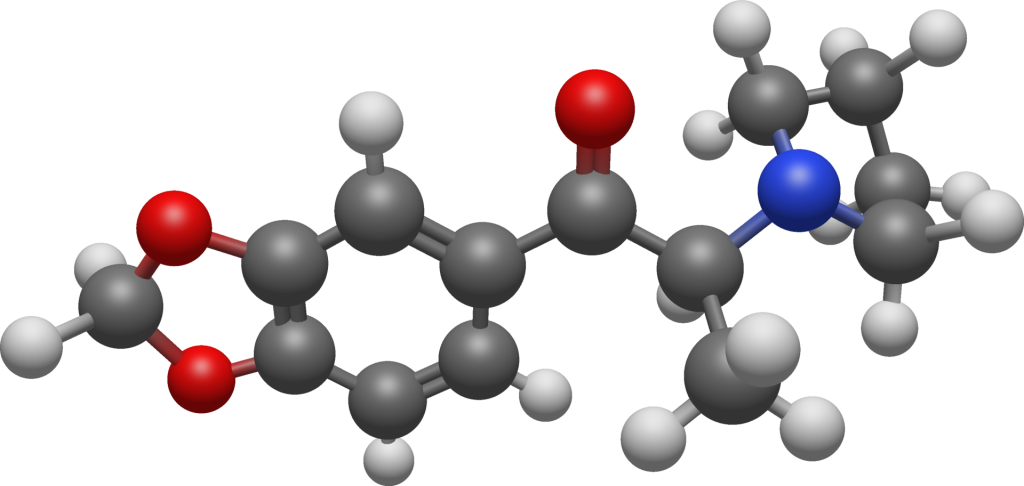Contents
- 1 Summary
- 2 Metabolism
- 3 Legal Status
- 4 FAQ
- 4.1 1. What is MDP?
- 4.2 2. How is MDP used?
- 4.3 3. When was MDP first identified?
- 4.4 4. What is the chemical structure of MDP?
- 4.5 5. Does MDP have reinforcing effects?
- 4.6 6. How is MDP metabolized in the body?
- 4.7 7. Is MDP legal?
- 4.8 8. What are the risks associated with MDP use?
- 4.9 9. Is there any legitimate medical use for MDP?
- 4.10 10. Is MDPPP similar to MDMA (Ecstasy)?
- 5 References
Summary
3′,4′-Methylenedioxy-α-pyrrolidinopropiophenone (MDP) is a designer stimulant drug. During the late 1990s and early 2000s, it was available in Germany and used as an ingredient in imitation ecstasy (MDMA) pills. MDP possesses a chemical structure akin to that of α-PPP and MDPV, and studies have demonstrated its reinforcing effects in rats.
| Identifiers | |
|---|---|
| IUPAC name | |
| CAS Number | 783241-66-7 |
|---|---|
| PubChem CID | 6430845 |
| ChemSpider | 4936183 |
| UNII | 83IP4LIH8E |
| Chemical and physical data | |
| Formula | C14H17NO3 |
| Molar mass | 247.294 g·mol−1 |

Metabolism
MDPPP seems to undergo a metabolic process similar to that of MDPV.
Legal Status
Since October 2015, MDPPP has been classified as a controlled substance in China.
FAQ
1. What is MDP?
MDP, short for 3′,4′-Methylenedioxy-α-pyrrolidinopropiophenone, is a synthetic stimulant drug. It belongs to the designer drug class and has been used recreationally.
2. How is MDP used?
MDP has been used illicitly and recreationally, typically by ingestion, snorting, or inhaling its vapours.
3. When was MDP first identified?
MDP was initially identified in the late 1990s and early 2000s when it was sold in Germany as an ingredient in imitation ecstasy (MDMA) pills.
4. What is the chemical structure of MDP?
MDP shares a similar chemical structure with α-PPP and MDPV. It is chemically classified as a substituted cathinone.
5. Does MDP have reinforcing effects?
Yes, studies in rats have suggested that MDP has reinforcing or rewarding effects.
6. How is MDP metabolized in the body?
MDP appears to undergo a metabolic process similar to MDPV, another stimulant drug.
7. Is MDP legal?
Laws regarding the legal status of MDP vary by country. As of October 2015, MDP is classified as a controlled substance in China.
8. What are the risks associated with MDP use?
The use of MDP carries potential health risks, including addiction, cardiovascular effects, and psychological side effects. It is essential to be cautious and informed about the risks associated with its use.
9. Is there any legitimate medical use for MDP?
No, MPD has no recognized legitimate medical use and is considered a recreational or illicit drug.
10. Is MDPPP similar to MDMA (Ecstasy)?
While MDP has been found in imitation ecstasy pills, it is a distinct substance and differs from MDMA both chemically and in its effects.
Please note that using MDP and similar substances can be illegal and dangerous, and it is essential to prioritize your health and well-being. If you have questions or concerns about specific substances or their effects, it is advisable to consult with a medical or addiction professional.
References
- A study conducted in August 2003 examined the metabolism and toxicological detection of the designer drug 3′,4′-methylenedioxy-alpha-pyrrolidinopropiophenone (MDPPP) in urine using gas chromatography-mass spectrometry. This research provided insights into how the body processes MDPPP and how it can be detected in biological samples.
- In April 2004, researchers published a synopsis covering the chemistry, pharmacology, toxicology, and hepatic metabolism of designer drugs, including those of the amphetamine (ecstasy), piperazine, and pyrrolidinophenone types. This comprehensive overview shed light on various aspects of designer drugs, including their effects and potential risks.
- Another study from June 2005 delved into the metabolism of designer drugs of abuse. It explored how these substances are broken down in the body, providing crucial information for understanding their effects and potential health risks.
- Research from March 2005 identified specific cytochrome P450 enzymes involved in the metabolism of MDPPP in human liver microsomes. This information contributes to our understanding of how the body processes MDPPP and its potential interactions with other substances.
- A study in May 2018 investigated the relative reinforcing effects of second-generation synthetic cathinones, which include substances like MDPPP. The study focused on self-administration and dose-response curves in rats, providing insights into the addictive potential of these substances.
- As of September 2015, MDPPP is classified as a controlled substance in China, as indicated by a notice from the China Food and Drug Administration.
These studies and regulatory actions help inform our understanding of MDPPP, its effects, and its legal status in different regions.